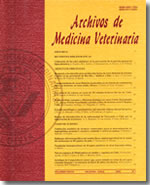Use of propidium ioide and Pisum sativum for fast assessment of acrosome integrity in goat spermatozoa
Main Article Content
Abstract
Lectins are used for studies in mammalian sperm surface and organelles because of their ability to specifically link sugar residua. Fluorescein labeled Pisum sativum (PSA) has been used successfully in several mammalian spermatozoa, as a marker of the inner acrosomal membrane but, because of interspecific variations in membrane constituents, its use requires a preliminary validation. This study compared the results obtained by staining goat spermatozoa with a combination of propidium ioide (PI) and PSA vs those of Bengal Red. Also the interpretation of the results achieved were compared with the results obtained by two external technicians.
In Experiment 1, goat spermatozoa collected by artificial vagina were washed once, immediately after collection, and stained with PI/PSA and Bengal Rose. Then, to prepare sperm groups with different proportions of live and dead sperm, spermatozoa were fractionated and one fraction was damaged by freezing at -196° C without cryoprotectans. In Experiment 2, semen from different males was frozen in a Tris-base d extender, and thawed either at 37° C for 30 sec or at 65° C for 5 sec, and then stained with PI/PSA. Two independent technicians assessed the results of both series of experiments. Percentage transformations, media comparison and correlation were obtained by using the Systat® computing package.
The results showed that PI/PSA and Bengal Rose gave similar and positively correlated results and that both technicians gave similar interpretations (r = 0.98). It can be concluded that PI/PSA is a useful staining for fast assessment of goat spermatozoa.

